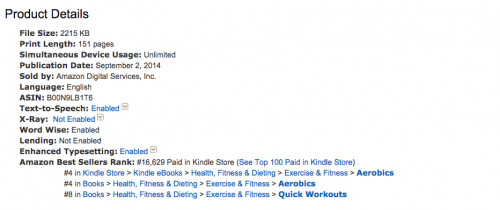Guess what? Steve and I are accepting ‘reader questions’ for the blog! We’re going to answer questions once a week, so if you want to submit your own question, you can shoot an email through to lise@authorbasics.com and we’ll let you know when it’s going to be answered 🙂
Our first question is one we’ve both been asked on separate occasions by different people. And it’s a tricky one. I know for me personally, I’m not much of a numbers person, but in order to make decisions about your author business going forward, you need to have some data.
Boring, I know, but without this information, you’ve got no idea what’s going on and whether you need to pivot, jump ship or continue as you have been.
In this post we’re going to focus on quite a few different metrics, so grab a cup of coffee(!) and make notes of what you need to be tracking and watch out for the bonus at the end 😉
What You Need to Track in Your Book Business
Before we get stuck in to the meat and potatoes of this post, it’s important to note that what you track in your book business is over and above what you would track during a book launch.
Briefly, here’s what you’d track during your book launch:
- Paid store best sellers rank
- Category rank
- Sales
This is just the bare-bones of what you’d track, there are a few other things you should be tracking, such as where the traffic is coming from during your book launch. We’ll cover book launch tracking in another post.
Today, we’re focusing on your entire book business. So let’s jump straight in the deep end and look at the things (for each published book) you should be tracking and keeping an eye on.
#1: Best Sellers Rank
This is where your book(s) sits overall in the Paid Amazon store. The best book is ranked at #1 and then it goes down from there. If you’re ranked #30,000 or less, then you should be making at least 1-10 sales per day.
It’s important that you’re tracking this information on a regular basis, like every 30 days. You need to have an idea of how well your book is doing and if it’s not doing so well, why.
If you want to make it easier on yourself, take note of this information every time you get paid from Amazon. For me, that’s around the 29th of each month.
If you’re not sure where to find your books sales rank, jump onto your books sales page on Amazon, scroll down until you see “Product Details” and you’ll see your book’s rank in the information that follows:
In the example above, you can see my rank for No Gym Needed.
Monitoring this, you can make decisions about whether you need to run a promotion or make changes to your book’s interior file based on feedback left in the comments section…
#2: Customer Comments
This isn’t something you necessarily need to track, but it is something you should check in on every month, just in case there are some issues you’re not aware of.
In one my second book, Side Hustle Blueprint, I opted not to go with a professional edit (I know! Naughty…) and because of this, there were a few grammatical errors that I missed. I only found this out from the comments I received on the books page. I was able to quickly update the book and let those people that had made those comments know that they could update their Kindle versions with the latest update.
A word of warning: don’t reply to negative comments that attack your character or say things like “this book is dumb, I didn’t get past page 4” etc, you’ll only make yourself look bad.
#3: Sales
This is probably the most important metric, right? We agree. Without sales, you’re not making any moola, at least not from Amazon! We should also advise that if you’re publishing your books on other platforms, like Kobo, iBooks etc, then you should also be tracking the same information there.
By keeping track of your sales, you’ll also be able to see how certain events affect your sales or whether one particular day out of the month was the best and then figure out why.
You’ll also be able to see trends in your sales once you’ve been tracking them for 6+ months, again keeping you informed on where you’re books are at and allowing you to make decisions accordingly.
#4: Special Events
If you launch a new book, this will likely result in more sales for your other books, so you want to make sure that you’re noting the dates that your event happens in that month.
You’ll also want to note any promotions you do, such as Thanksgiving, Black Friday etc. This allows you to see how those events affect your sales.
You should also keep track of special dates for each month to see if that increases your sales because people are online (or offline) more.
#5: Email List Signups
Your books should be driving people to your email list signup, if they aren’t, make sure you check out how to set this up in one of our previous blog posts.
You’ll be able to see your email signup metrics from your email service provider. If you’re using Mailchimp (which we highly recommend), then you’ll be able to find this information by clicking on the list name (under Lists) and then sorting your list by the “date added” column. You’ll quickly be able to see how many people joined throughout the month.
This metric is particularly important if you’ve utilized the permafree method we wrote about a few weeks ago. Email signups are what you want for your permafree book so if you’re not getting a lot, then you need to look at your offer or your signup form. 3+ signups a day is normal for a permafree book.
#6: Book Production Costs/Overheads
It’s important that you also track the expenses your book business incurs. I’m the first to put my hand up and say that this is not something I was doing until recently, like I said, this kind of stuff is super boring to me!
But it was brought to my attention that I wasn’t getting a true reflection of my author earnings without adding in these costs, so now I track these with everything else outlined above.
The types of things I include in my overheads are:
- Book cover design costs
- Book promotion costs
- Editing costs
- Social media image costs
By tracking this information, you can start to see if you’re actually making money or just breaking even.
#7: Categories
Tracking the categories that your books are in is key to informing a decision on whether to change them or not, in comparison with your sales and other events.
It’s helpful to have a few different categories that your book can switch between when needed. Sometimes there might be an influx of new books in your category, this could be a good time to change it and then come back in another 30 days. It also gives you the ability to get new eyes on your book that wouldn’t otherwise find you.
#8: Keywords
Are you tracking your keywords? Are you using keywords?? Every time you publish a new book, you’re given the opportunity to add up to 7 keywords in the KDP dashboard. You should always do this.
I aim to have at least 14 keywords (if not more) that I can change as needed. I check my keywords every 30 days to make sure that my books are still ranking in an Amazon search (on the first page) for those keywords.
If they aren’t, then it’s time to try a new keyword or one that I’ve used in the past.
The two best places to find good keywords are:
Both of these require payment to get access, although you can use a limited version of Merchant Words for free.
If you don’t have the funds, then you can find new keywords the long way be jumping on Amazon and typing in some keywords from your book and seeing what auto generates in the drop-down search box (see image below).
Once you’ve got some results (you’re looking for search results between 1000 – 5,000) then you can start trialling them with your book.
These are just some of the things you should be tracking. For each person, there might be other things you want to track, such as Facebook page signups or course signups (if you have one).
The important thing to remember is that you need to be consistent with this, otherwise it can be difficult to scale and move forward in your business without actually knowing where you stand.
To make it easier on you guys, we’ve created a spreadsheet that you can use to track your own book business! Grab your bonus book tracking spreadsheet here!



